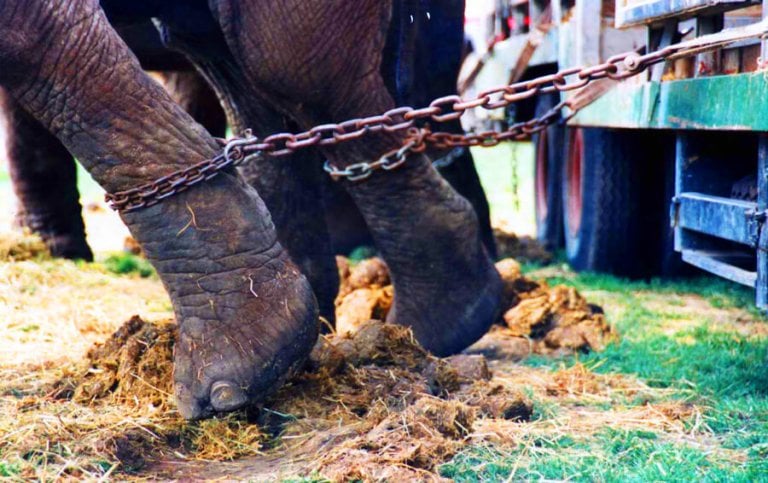The Way Elephants Are Artificially Inseminated Will Give You Nightmares
When an animal exhibitor wants to produce a new baby elephant, you can bet that a captive female elephant will be put through years of torment in order to sell more tickets to shows.
As an investigative report by The Seattle Times found, “the decades-long effort” to breed elephants in captivity “is failing, exacerbated by substandard conditions and denial of mounting scientific evidence that most elephants do not thrive in captivity.” Despite staggering infant mortality rates for captive elephants, exhibitors continue to force them to breed, increasingly through a grueling artificial insemination process.

First, the elephant is “trained” to stand still and accept having all manner of devices shoved into her body. Then, handlers sedate and immobilize her, often with chains wrapped around her legs. They manually remove the feces from her rectum and flush it out with water. They use an electric air pump and air tube or a balloon catheter to force open her vestibule in order to access her vagina and cervix. After that, breeders insert an endoscope and push it all the way to the back of her vagina or into the cervix, followed by an insemination catheter, which they attempt to push through her cervix and into the uterus. Staff simultaneously monitor the procedure with a transrectal ultrasound.
Female elephants have the longest reproductive tracts of any mammal: approximately 3 to 5 feet. And these tracts run vertically through their pelvis and then curve horizontally, making access to the cervix for insemination difficult. The procedure may take hours.
“Elephants have three openings on their cervix, but two are false,” says elephant trainer Don RedFox. “You kind of have to get in there and probe around to find the correct opening and then deliver the semen,” he said, admitting that the procedure is “uncomfortable” for the elephants.
Zoos typically repeat the insemination process many times during the elephant’s four-month reproductive cycle—often for years before she ever conceives. If she does conceive, they subject her to many more invasive ultrasounds and other procedures during her approximately 22-month pregnancy. Elephants are frequently chained while giving birth and don’t have female family members assisting them as they would in the wild.
It’s also common for female elephants to be artificially inseminated at a much younger age than the one at which they would reproduce in nature. Wild Asian elephants don’t usually have their first calves until they’re between 14 and 20 years old. In its attempt to increase the number of captive elephants it uses for profit, Ringling Bros.’ Center for Elephant “Conservation” impregnated elephant Shirley and forced her to give birth to baby Riccardo when she was just 8 years old. It then forced her to bear infant Mable at age 11 and baby Piper at age 17.
One of Ringling’s vets also promotes an experimental procedure known as surgical insemination. It consists of cutting a path through the elephant’s body and into her reproductive tract, inserting a tube through the cervix, and injecting semen directly into her uterus. It’s just as excruciating as it sounds.
When artificial insemination procedures are successful, the resulting calves often don’t survive the first few years of life. The first-year mortality rate for captive Asian elephants is more than 30 percent. Young elephants are highly susceptible to infection with the deadly herpes virus, which disproportionately affects captive babies. Animal exhibitors also frequently take the mothers’ calves away from them when the babies are very young, either for “training” (to be broken) or so that they can be transferred to a different facility to increase ticket sales there.
As one Ringling spokesperson admitted:
“We’re not a conservation organization. We’re a circus.”
These elephants are never released back into nature to help sustain dwindling wild-elephant populations. They’re treated as if their only purpose is to entertain humans and make money for exhibitors.
Imagine what it must be like as a female when strangers who don’t speak your language hold you captive and routinely examine, touch, and manipulate your reproductive system without your consent. Essentially, captive elephants are repeatedly raped.
Elephants’ lives in nature are completely different from their existence in captivity. They live in tight-knit, female-centric, matriarchal herds. They protect one another, forage for fresh vegetation together, play, bathe in rivers, and are constantly active. They truly understand that “it takes a village to raise a child”—all the females share mothering responsibilities for the herds’ babies, and they assist each other during pregnancy and labor. They’re sensitive and deeply emotional individuals whose ability to feel pain, sorrow, joy, happiness, and love rivals our own.

As world-renowned elephant expert Dr. Joyce Poole explains:
“Elephants, too, are capable of empathizing with others … and have even been observed to wince when a companion reaches its trunk out toward an electric wire. . . . These two capacities, social learning and empathy, mean that when an elephant is beaten, grabbed, jabbed, poked, bopped, or pulled with a bullhook, this action has negative psychological consequences both for the individual elephant receiving the negative treatment and also for nearby elephants.”
Abuse of captive elephants doesn’t just hurt the victim, it hurts all the empathetic females who are suffering with her.
Yes, elephant captivity is a feminist issue.
Help fight sexism and sexual abuse in all their forms. Refuse to patronize elephant exhibitions, circuses, rides, and other abusive tourist traps, and urge travel companies to stop promoting elephant rides today.




